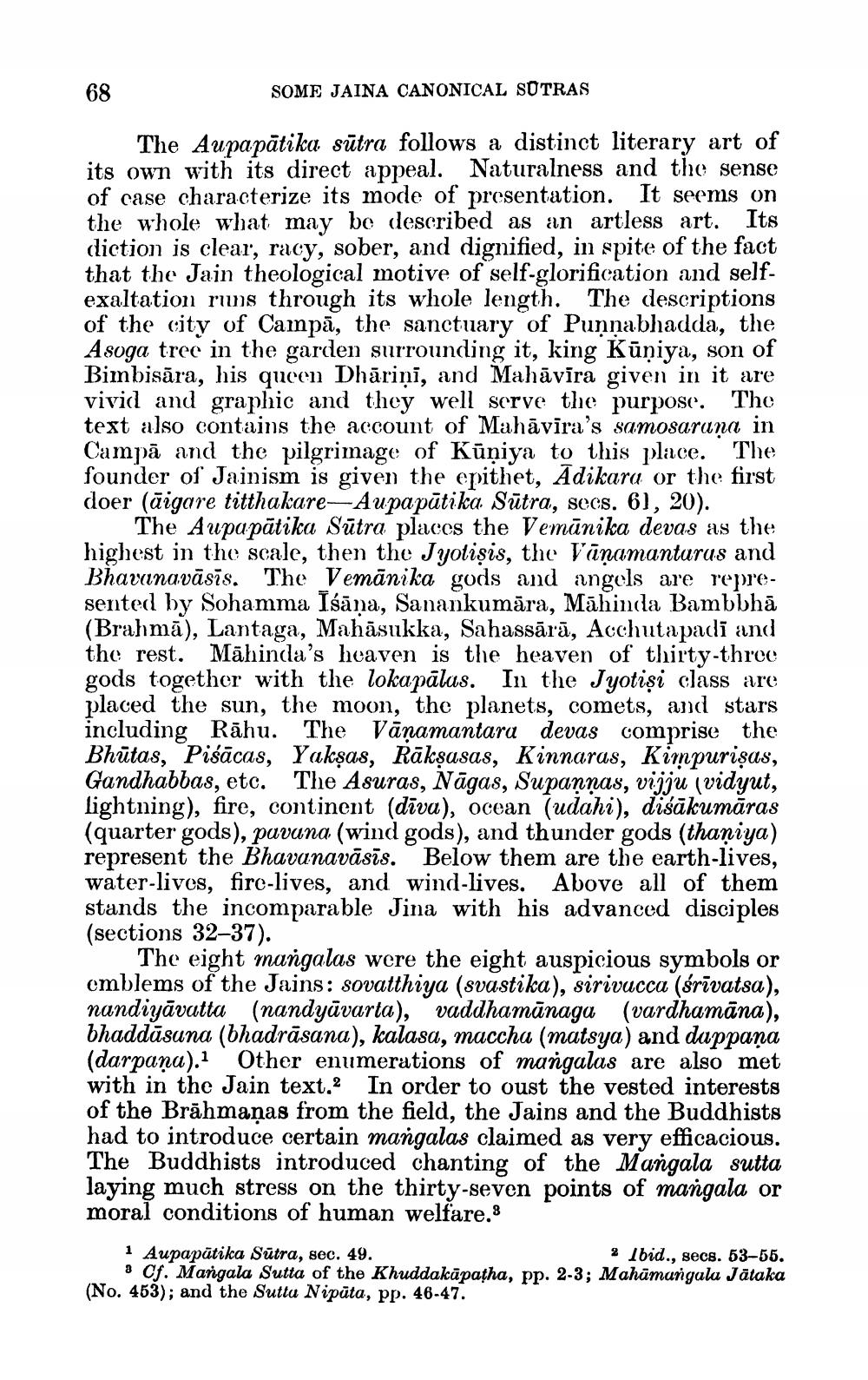________________
SOME JAINA CANONICAL SUTRAS
The Aupapātika sutra follows a distinct literary art of its own with its direct appeal. Naturalness and the sense of case characterize its mode of presentation. It seems on the whole what may be described as an artless art. Its diction is clear, racy, sober, and dignified, in spite of the fact that the Jain theological motive of self-glorification and selfexaltation runs through its whole length. The descriptions of the city of Campa, the sanctuary of Punnabhadda, the Asoga tree in the garden surrounding it, king Kūniya, son of Bimbisara, his queen Dhariņi, and Mahāvīra given in it are vivid and graphic and they well serve the purpose. The text also contains the account of Mahavira's samosarana in Campa and the pilgrimage of Kuniya to this place. The founder of Jainism is given the epithet, Adikara or the first doer (aigare titthakare-Aupapātika Sutra, secs. 61, 20).
The Aupapatika Sutra places the Vemānika devas as the highest in the scale, then the Jyotiṣis, the Vaṇamantaras and Bhavanavasis. The Vemanika gods and angels are represented by Sohamma Iśāna, Sanankumāra, Mahinda Bambbhā (Brahma), Lantaga, Mahāsukka, Sahassārā, Acchutapadi and the rest. Mahinda's heaven is the heaven of thirty-three gods together with the lokapalas. In the Jyotiși class are placed the sun, the moon, the planets, comets, and stars including Rahu. The Vanamantara devas comprise the Bhutas, Pisacas, Yaksas, Rākṣasas, Kinnaras, Kimpurisas, Gandhabbas, etc. The Asuras, Nagas, Supannas, vijju (vidyut, lightning), fire, continent (diva), ocean (udahi), diśākumāras (quarter gods), pavana (wind gods), and thunder gods (thaniya) represent the Bhavanavāsīs. Below them are the earth-lives, water-lives, fire-lives, and wind-lives. Above all of them stands the incomparable Jina with his advanced disciples (sections 32-37).
68
The eight mangalas were the eight auspicious symbols or emblems of the Jains: sovatthiya (svastika), sirivucca (śrīvatsa), nandiyāvatta (nandyāvarta), vaddhamanaga (vardhamāna), bhaddasana (bhadrasana), kalasa, maccha (matsya) and dappana (darpana). Other enumerations of mangalas are also met with in the Jain text.2 In order to oust the vested interests of the Brahmanas from the field, the Jains and the Buddhists had to introduce certain mangalas claimed as very efficacious. The Buddhists introduced chanting of the Mangala sutta laying much stress on the thirty-seven points of mangala or moral conditions of human welfare."
1 Aupapātika Sutra, sec. 49.
2 Ibid., secs. 53-55.
a Cf. Mangala Sutta of the Khuddakapatha, pp. 2-3; Mahamangala Jātaka (No. 453); and the Sutta Nipāta, pp. 46-47.




